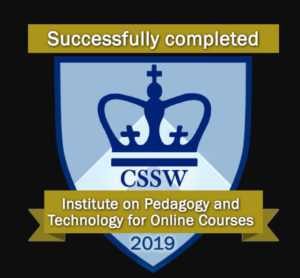Reflections from the Summer 2019 Institute on Pedagogy and Technology for Online Courses

Growing up, I loved summertime! I have some fond memories of traveling, riding my bike, swimming, and general goofing off. Now, this past summer I worked….okay, there was a little swimming and a lot of traveling, and I took an online course. Not just any course; I am a proud graduate of the Columbia School of Social Work’s Institute on Pedagogy and Technology for Online Courses. In what has to be the most tardy “what I did over the summer” essay ever, I want to share why I took this course and more importantly, my key takeaways from this experience.
The Institute has been around since 2017 and consists of five weeks of modules with a two-hour live session and homework each week. While it is geared toward training instructors for Columbia’s Online Social Work Program, anyone can apply for the Institute, and completing the training doesn’t obligate one to teach for Columbia’s Online Social Work Program. The Institute models what a typical online course is like at Columbia, and incorporates many best practices for how to teach an online course. In fact, the Institute has won awards from the International E-Learning Association and United States Distance Learning Association. To learn more about the Institute I recommend the following articles:
Ryan, D. E., Marquart, M. S., Baez, J. C., Garay, K., & Chung, R. (2019). Recruiting, Training, and Engaging Virtual Faculty via an Award-Winning Online Pedagogy Institute—#SWDE2019. https://doi.org/10.7916/d8-hdtz-wj08
Báez, J. C., Marquart, M., Chung, R. Y.-E., Ryan, D., & Garay, K. (2019). Developing and Supporting Faculty Training for Online Social Work Education: The Columbia University School of Social Work Online Pedagogy Institute. Journal of Teaching in Social Work, 39(4–5), 505–518. https://doi.org/10.1080/08841233.2019.1653419
Before starting the 2019 Summer Institute, I set myself the goal of learning how to better facilitate live sessions for online education. This is what I truly needed to learn because most of my online education experience is with asynchronous courses. Because of this learning goal, I discussed what I learned about facilitating live online sessions in each of my weekly course reflections. I am sharing content from these reflections (edited) to present what I learned and offer some tips and ideas that others could incorporate into live sessions for online courses.
Week 1 – Plan out your live session in advance, scaffolding the digital tools for early successes.
As I was participating in this week’s live session, I was struck by the attention the instructional team paid to introducing Adobe Connect to the participants, both from a design and teaching perspective. I saw steps of scaffolding throughout the session that helped build my confidence with the software. In terms of teaching, the attention to building social presence within the session was obvious such as using people’s names, asking people to stay on camera until all had reported out, and encouraging fun and engaging comments in the chat feature.
As I participated in the session, I started writing down all the processes and tasks that I observed from the session and the instructional team. Here are some of my initial thoughts on how to design an effective live session:
- Clear directions in advance on why and how to participate in a live session, and include a rubric for participate
- Easy to find log-on for the session within the Learning Management System (LMS)
- Build social presence with music and engagement via the chat feature
- Use simple presentation slides with some graphics
- Start with a “lobby” slide explaining what is going on; include music, respond to questions, and welcome the participants
- Be prepared for tech problems and take them into private chats
- Start on time and end on time
- Include a break
- Use the tools of the system as appropriate to the learning activity – polls, breakout rooms, etc
Some of these activities are specific to the tools in Adobe Connect. Since my institution uses Zoom, I will need to translate this list for that platform.
Week 2 – Assess and develop your own online collaborative competencies.
As I noted in my discussion post for this week, one of my biggest takeaways from the week was reading about Bower’s (2011) four levels of online collaborative competencies. I absolutely love a good framework to help me organize my thinking on a topic, and his framework includes only four competencies for leading a live session:
- Operational – being able to use all the digital tools
- Interactional – being about to perform a task or problem-solve with the digital tools
- Managerial – manage a group
- Design – select and organize tools for the best interactions and management
He notes that these competencies build upon each other in a hierarchical way. I could easily see a simple self-assessment tool for online instructors based on this framework, and incorporating the digital tools from a specific learning management system and supporting software. Maybe a list of the types of tools first, and then the person completing the self-assessment fills in the names of the tools from the LMS that they are working in.
Week 3 – Use different class activities to build community, including a dance party.
The one section of this week’s live session class that was helpful for me was about building community with students in an online course prior to the semester and at the start of the semester. Here are some of the examples activities that help build community:
- a welcome announcement
- a written discussion forum with introductions prior to class with different questions
- breakout session based on the discussion
- another discussion forum where students share photos or other information
- providing photos of celebrations of accomplishments from students in class
- offer a review of questions based on the course material
- have a fun activity for the break including self-care or graduation activities
- end the session with a virtual dance party
Week 4 – Be compassionate as the tech will fail sometimes.
My learning for this week’s live session came all from the challenges I faced when trying to log into this week’s session. I had two challenges:
- I was traveling by car from Wisconsin back home to Birmingham and we were in the middle of the driving when I needed to stop for class. Even with planning, bad traffic delayed us and we got to the Nashville Library late.
- My laptop’s battery quit working so I couldn’t use the laptop. I had to rely on my iPad which didn’t have the functionality I needed, even with the Adobe Connect app.
I had planned to stop in Nashville at their downtown library and get a group room, which had power outlets and hard wired connections for my laptop. I even planned to get to the library 45 minutes before class started. None of that worked out and I have now realized how important it is to have multiple backup plans for technology when taking an online class. The entire time I was struggling to get to the library and into the session, I thought about what my students might have experienced or would experience in future classes. I also missed submitting some homework on time because of traveling, being tired, and not planning well. Again, I found a soft spot of compassion for my students, who have struggled in the past. I think more than anything I learned the importance of holding space for compassion and empathy with my students, regardless of the course.
This week’s reading about tone in written email communication helped me to reflect on text-based communication generally. Dickinson’s (2017) study on how tone affected student performance and teacher evaluations suggests that attention and thoughtfulness in text-based communication can have positive learning outcomes for students. I wonder if this extends to all types of text-based communication. For example, I was struggling with my tech for this week’s live session and I reached out to the Associate/TA to let her know I was present, but late to log into the session. Her response was friendly and welcoming. She acknowledged that tech issues happen and offered her assistance. This immediately put me at easy. I was able to calm down enough to focus and engage with the class. I also noticed that I responded positively to the comments from the class chat that were supportive and friendly; not that anyone would respond otherwise. It was just a dramatic reminder for me how important tone is during live virtual sessions.
Week 5 – Don’t wear stripes on camera.
I had two big takeaways from this week’s live session. First, think about what you wear for online live classes. I plan to pay more attention to what I am wearing in my videos and online sessions. Some colors and patterns don’t look well through a web cam. For example, I love striped clothing, but on camera it creates the Morie Effect, which shows the stripes as moving and very unpleasant to look at. I will have a scarf and sweater available on the back of my chair at work and home to slip on as needed.
If you have participated in the Institute, I would love to hear what your big takeaways were from the training. Please leave a comment below. If you haven’t participated in the Institute, please consider participating in the next one. You can learn more by following Matthea Marquart, the Director of Administration for Columbia’s Online Campus, on Twitter at @MattheaMarquart. She will tweet announcements and the application for the Spring 2020 Institute.
My thanks to the entire instructional team from the 2019 Summer Institute for a great learning experience, and grading all my assignments while gracefully managing my insecurities and questions.
References:
Bower, M. (2011). Synchronous collaboration competencies in web‐conferencing environments – their impact on the learning process. Distance Education, 32(1), 63–83. https://doi.org/10.1080/01587919.2011.565502
Dickinson, A. (2017). Communicating with the Online Student: The Impact of E-Mail Tone on Student Performance and Teacher Evaluations. Journal of Educators Online, 14(2). Retrieved from https://eric.ed.gov/?id=EJ1150571
How to cite this blog post:
Hitchcock, L.I. (2019, November 19). Reflections from the Summer 2019 Institute on Pedagogy and Technology for Online Courses [Blog Post]. Retrieved from: https://laureliversonhitchcock.org/2019/11/19/reflections-from-the-summer-2019-institute-on-pedagogy-and-technology-for-online-courses/



November 19, 2019
I learned a lot about making your online course design flow like a narrative. Instructors often complain about using course management systems, but they don’t work if we think of them as a mere storage locker.
Also, I learned about looking straight into the camera and keeping your background tableau simple!